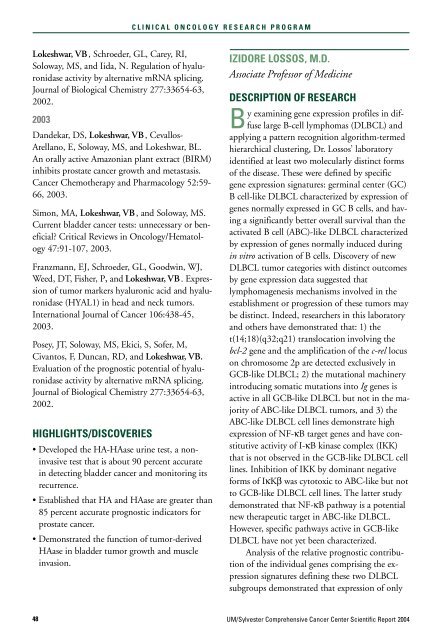SCIENTIFIC REPORT 2004 - Sylvester Comprehensive Cancer Center
SCIENTIFIC REPORT 2004 - Sylvester Comprehensive Cancer Center
SCIENTIFIC REPORT 2004 - Sylvester Comprehensive Cancer Center
Create successful ePaper yourself
Turn your PDF publications into a flip-book with our unique Google optimized e-Paper software.
C L I N I C A L O N C O L O G Y R E S E A R C H P R O G R A M<br />
Lokeshwar, VB , Schroeder, GL, Carey, RI,<br />
Soloway, MS, and Iida, N. Regulation of hyaluronidase<br />
activity by alternative mRNA splicing.<br />
Journal of Biological Chemistry 277:33654-63,<br />
2002.<br />
2003<br />
Dandekar, DS, Lokeshwar, VB , Cevallos-<br />
Arellano, E, Soloway, MS, and Lokeshwar, BL.<br />
An orally active Amazonian plant extract (BIRM)<br />
inhibits prostate cancer growth and metastasis.<br />
<strong>Cancer</strong> Chemotherapy and Pharmacology 52:59-<br />
66, 2003.<br />
Simon, MA, Lokeshwar, VB , and Soloway, MS.<br />
Current bladder cancer tests: unnecessary or beneficial?<br />
Critical Reviews in Oncology/Hematology<br />
47:91-107, 2003.<br />
Franzmann, EJ, Schroeder, GL, Goodwin, WJ,<br />
Weed, DT, Fisher, P, and Lokeshwar, VB . Expression<br />
of tumor markers hyaluronic acid and hyaluronidase<br />
(HYAL1) in head and neck tumors.<br />
International Journal of <strong>Cancer</strong> 106:438-45,<br />
2003.<br />
Posey, JT, Soloway, MS, Ekici, S, Sofer, M,<br />
Civantos, F, Duncan, RD, and Lokeshwar, VB.<br />
Evaluation of the prognostic potential of hyaluronidase<br />
activity by alternative mRNA splicing.<br />
Journal of Biological Chemistry 277:33654-63,<br />
2002.<br />
HIGHLIGHTS/DISCOVERIES<br />
• Developed the HA-HAase urine test, a noninvasive<br />
test that is about 90 percent accurate<br />
in detecting bladder cancer and monitoring its<br />
recurrence.<br />
• Established that HA and HAase are greater than<br />
85 percent accurate prognostic indicators for<br />
prostate cancer.<br />
• Demonstrated the function of tumor-derived<br />
HAase in bladder tumor growth and muscle<br />
invasion.<br />
IZIDORE LOSSOS, M.D.<br />
Associate Professor of Medicine<br />
DESCRIPTION OF RESEARCH<br />
By examining gene expression profiles in diffuse<br />
large B-cell lymphomas (DLBCL) and<br />
applying a pattern recognition algorithm-termed<br />
hierarchical clustering, Dr. Lossos’ laboratory<br />
identified at least two molecularly distinct forms<br />
of the disease. These were defined by specific<br />
gene expression signatures: germinal center (GC)<br />
B cell-like DLBCL characterized by expression of<br />
genes normally expressed in GC B cells, and having<br />
a significantly better overall survival than the<br />
activated B cell (ABC)-like DLBCL characterized<br />
by expression of genes normally induced during<br />
in vitro activation of B cells. Discovery of new<br />
DLBCL tumor categories with distinct outcomes<br />
by gene expression data suggested that<br />
lymphomagenesis mechanisms involved in the<br />
establishment or progression of these tumors may<br />
be distinct. Indeed, researchers in this laboratory<br />
and others have demonstrated that: 1) the<br />
t(14;18)(q32;q21) translocation involving the<br />
bcl-2 gene and the amplification of the c-rel locus<br />
on chromosome 2p are detected exclusively in<br />
GCB-like DLBCL; 2) the mutational machinery<br />
introducing somatic mutations into Ig genes is<br />
active in all GCB-like DLBCL but not in the majority<br />
of ABC-like DLBCL tumors, and 3) the<br />
ABC-like DLBCL cell lines demonstrate high<br />
expression of NF-κB target genes and have constitutive<br />
activity of I-κB kinase complex (IKK)<br />
that is not observed in the GCB-like DLBCL cell<br />
lines. Inhibition of IKK by dominant negative<br />
forms of IκKβ was cytotoxic to ABC-like but not<br />
to GCB-like DLBCL cell lines. The latter study<br />
demonstrated that NF-κB pathway is a potential<br />
new therapeutic target in ABC-like DLBCL.<br />
However, specific pathways active in GCB-like<br />
DLBCL have not yet been characterized.<br />
Analysis of the relative prognostic contribution<br />
of the individual genes comprising the expression<br />
signatures defining these two DLBCL<br />
subgroups demonstrated that expression of only<br />
48<br />
UM/<strong>Sylvester</strong> <strong>Comprehensive</strong> <strong>Cancer</strong> <strong>Center</strong> Scientific Report <strong>2004</strong>
















